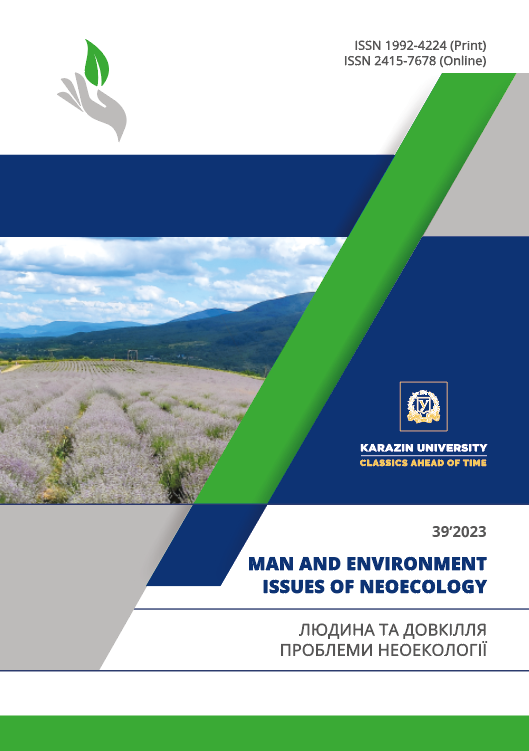Methodology for determining the suitability of soils for afforestation in plain part of Ukraine
Abstract
Purpose. To develop a methodology for assessing forest suitability for certain varieties of unproductive soils.
Methods. There are used the classical methods of soil science, agrochemistry, forest science, forest management, typology and mathematical statistics.
Results. The principles of forest typology are the basis for determining the suitability of soils for forestation. Its essence lies in a comprehensive study of soil properties (soil morphometry, chemical composition) and forestry characteristics of forest stands, as well as an analysis of the grass-shrub layer by ecomorphs. The results of studies of the combined study of the productivity of forest stands and the properties of the main varieties of unproductive soils (sandy, eroded and skeletal) in different natural zones of the plain part of Ukraine are presented. Determination of the suitability of soils for forestation was assessed according to three categories: 1) unsuitable for forestation and conditionally suitable for forestation (very dry, very poor, toxic, with a limited rhizosphere zone, inaccessible or hardly accessible for cultivation); 2) limited suitability for forestation (dry and poor soils); 3) suitable for forestation. Packages of markers have been developed, on the basis of which it is possible to assess both their forest suitability and determine the type of forest growth conditions of non-forest lands. When compiling markers, preference was given to such soil indicators, which, along with informativeness in relation to soil quality, did not require complex methods of determination. The composition of markers includes morphological, physical, agrochemical parameters and depends on the type of soil.
Conclusions. The developed packages of markers are the basis for the scientifically based creation of forests on unproductive lands, on which forest vegetation did not grow before. Their use in afforestation increases its efficiency and makes forests more resistant to adverse environmental factors. The Methodology is intended for forestry specialists, it can be used at enterprises, institutions of the forest sector, forest design organizations, as well as in related industries concerned with the protection and rational use of natural resources. The methodological developments can be included in the curricula of secondary and higher forestry-oriented education institutions.
Downloads
References
State strategy of forest management of Ukraine up to 2035. (2021). Decree of the Cabinet of Ministers of Ukraine No. 1777-r dated December 29, 2021. Retrieved from https://zakon.rada.gov.ua/laws/show/1777-2021-%D1%80#Text
Hansson, K., Laclau, J.-P., Saint-André, L., Mareschal, L., Heijden, G., Nys, C. …Legout, A. (2020). Chemical fertility of forest ecosystems. Part 1: Common soil chemical analyses were poor predictors of stand productivity across a wide range of acidic forest soils. Forest Ecology and Management, 461. https://doi.org/10.1016/j.foreco.2019.117843
Raspopina, S. P. (2017). Scientific basis of assessment of forest growth potential and forestation suita-bility of soils of the flat part of Ukraine. Extended abstract of D.Sc. thesis. 42. (In Ukrainian).
Teleshek, Yu. K.; Zamlelyi, V. V.; Orlov, A.N., & Olkhovskyi, A.F. (1982). Methodological guidelines on the technology of creating forest-reclamation plantations on steep rocky banks of the hydrographic network in the flat areas of the Ukrainian SSR. 31. (In Ukrainian).
Chornyi S.G., & Vilna (Poliashenko) N.V. (2019). Updating of "The Index Productivity of Peirce» and its application for an estimation of chernozem soils quality in the Right-bank Steppe of Ukraine. (88), 31-39. https://doi.org/10.31073/acss88-04. (In Ukrainian).
Gladkyi, O.S. (1960). Soil and forest-growth conditions of the Lower Dnieper (Oleshkiv) sands. Scien-tific works of UkrNDILGA. 20, 68-79. (In Ukrainian).
Raspopina, S., Degtyarjov, V., & Chekar, O. (2021). Comparative Evaluation of the Sandy Soils of Pine Forests in Ukraine: Soils Under Stress.Springer, Cham. https://doi.org/10.1007/978-3-030-68394-8_15
Migunova, O.S. (1974). Methodological guidelines for soil survey of saline lands. 33. (In Ukrainian).
Ponette Q., Bispo A., Brethes A., Dupouey J-L., Feix I, Gégout J.-C. … Rangeet J. Fertility indicators in temperate forest soils: issues, approaches and prospects. (2014). Hal science ouverte. https://doi.org/10.4267/2042/56269
Zhao W., Cao X., Li J., Xie Z, Sun Y., Peng Y. Novel weighting method for evaluating forest soil fertility index: a structural equation model. Plants (Basel, Switzerland), 12(2), 410. https://doi.org/10.3390/plants12020410.
Baliuk S., Medvedev V., Miroshnichenko M., Skrylnik Ye., Timchenko D., Fatieev A… Tsapko Yu. (2012). Environmental state of soils in Ukraine. Ukrainian Geographical Journal, 2, 38-42. Retrieved from http://nbuv.gov.ua/UJRN/UGJ_2012_2_9. (In Ukrainian).
Ostapenko B.F. & Tkach V.P. (2002). Forest typology. 204 (in Ukrainian).
Copyright (c) 2023 Raspopina S. P.

This work is licensed under a Creative Commons Attribution 4.0 International License.
Authors reserve the right of attribution for the submitted manuscript, while transferring to the Journal the right to publish the article under the Creative Commons Attribution License 4.0 International (CC BY 4.0). This license allows free distribution of the published work under the condition of proper attribution of the original authors and the initial publication source (i.e. the Journal)
Authors have the right to enter into separate agreements for additional non-exclusive distribution of the work in the form it was published in the Journal (such as publishing the article on the institutional website or as a part of a monograph), provided the original publication in this Journal is properly referenced
The Journal allows and encourages online publication of the manuscripts (such as on personal web pages), even when such a manuscript is still under editorial consideration, since it allows for a productive scientific discussion and better citation dynamics (see The Effect of Open Access).





